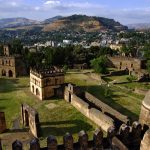Ethiopia’s Enduring Cultural Heritage
Ethiopia’s dramatic topography has in some measure influenced one of Africa’s distinctive longstanding cultural traditions. It is dominated by a volcanically formed mountainous plateau known as the Ethiopian Highlands that reaches up to 4,600 meters above sea level. This formation is bisected by the Great Rift Valley, which extends from the Red Sea to the Danakil Depression, where humanity evolved and the earliest evidence of our ancestors has been discovered.
In antiquity, an important civilization arose in northern Ethiopia that extended beyond the shores of the Red Sea. Ranked as one of the great empires of its day, during the first half of the first millennium, Aksum was based inland but developed a vital connection to the outside world through the port of Adulis. In the second century A.D., Ptolemy refers to “Aksum where the palace of the king is located.” In addition to its overland contacts with Meroë, the Nile Valley, and Egypt, its access to the Red Sea allowed it to become an active participant in trade with the Roman provinces, the Mediterranean, southern Arabia, Sri Lanka, and China. Among its exports were ivory, gold, aromatics such as frankincense and myrrh, slaves, and salt. By the third century, the demand for its goods warranted a monetary system of coinage whose weights, standards, and designs corresponded to that of Rome and later Byzantium. At the height of its power and prosperity, Aksum expanded to incorporate the region of Saba, in modern-day Yemen, within its borders.
The most impressive surviving evidence of Ethiopia’s artistic past is its stone monuments. Among the colossal stelae carved from single blocks of granite to mark the burial sites of pre-Christian potentates at Aksum is the largest monolith ever quarried and transported. At Aksum, texts in Greek, Sabean, and Ge’ez (the classical antecedent to Amharic) inscribed on stone tablets also attest to the fourth-century emperor Ezana’s embrace of Christianity and conquest of Yemen within a decade of Constantine’s legalization of Christianity in the Roman empire.
Over the centuries, the leaders of this outpost of Christianity closely identified with the Holy Land and saw themselves as a chosen people. This is reflected in the apocryphal text of the Kebra Nagast (Glory of Kings), which recounts the Aksumite queen Makeda’s journey to Jerusalem to visit King Solomon. According to that narrative, their union yielded the future king of Ethiopia, Menilik, who crossed the Red Sea to claim his birth right, carrying with him the Ark of the Covenant now believed to be housed within the Cathedral of Saint Mary Zion in Aksum. That cathedral was founded in Ezana’s era with the establishment of the Orthodox Church. It subsequently served as the place for the coronation of all kings and consciously evokes its namesake in Jerusalem, the site of the Last Supper.
As an integral part of their forging and embracing of this ideology of Old Testament devotion and leadership, the faithful transformed the landscape by cutting thousands of churches from the living rock. The most remarkable and renowned example of these rock-cut churches is the pilgrimage site of Lalibela, in the Tigray mountains, dated to the thirteenth century. The wondrous accomplishment of that cluster of eleven structures excavated from the tufa, envisioned as a New Jerusalem and credited to the labours of angels, required an architectural genius capable of conceptualizing before work began every aspect of the design, from its interior spaces to exterior details.
Monasteries, such as those founded throughout the Tigray region, played an essential role in the dissemination of Christianity as the emperors expanded their territories. In Ethiopia, monasticism historically was a vocation favoured by those of aristocratic origin as an alternative to a political career. It was in these centres of learning where devotional art such as illuminated manuscripts, icons, and processional crosses were created by monks for their patrons: abbots, nobles, and emperors. Relying initially on predominantly Byzantine models, they decisively departed from these prototypes to develop their own distinctive idiom favouring bold colours and two-dimensional abstract design.
The artistic expressions of faith they produced have endured through countless conflicts and threats to their survival. Christian Ethiopia was gradually isolated from the outside world beginning in the ninth century by increasingly powerful Islamic neighbours. In 1526, the Muslim general Ahmed Gragn launched what he described at the time as a jihad against the Christian north that devastated the region and spared only those churches carved of rock. In 1868, a dispute with the British counsel led to the defeat of Emperor Tewodros at the crushing Battle of Mäqdäla. In 1896, Emperor Menelik successfully deflected Italy’s attempt to colonize the Ethiopian heartland at the Battle of Adwa. The works illustrated here reflect Africa’s longstanding ties to the world at large and the resilience of a major artistic tradition.
Alisa LaGamma
Department of Arts of Africa, Oceania, and the Americas, the Metropolitan Museum of Art
Source: http://www.metmuseum.org




Leave a Reply